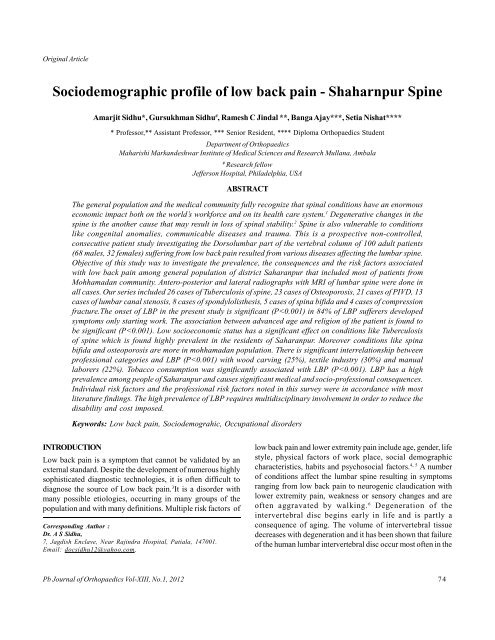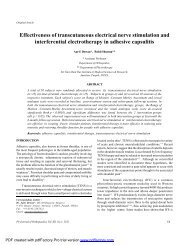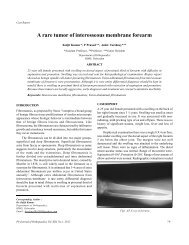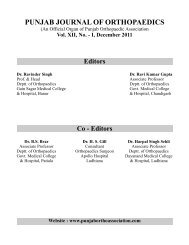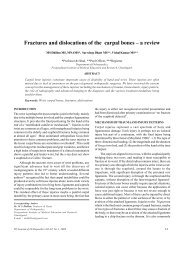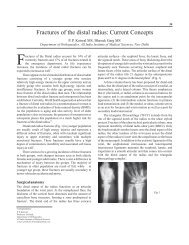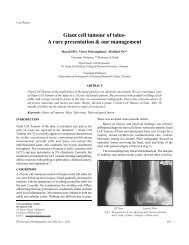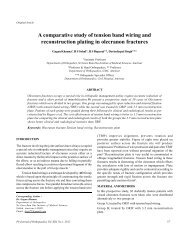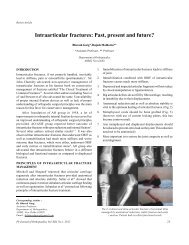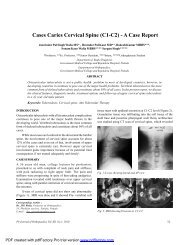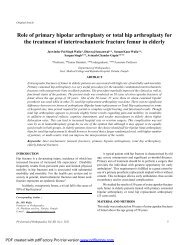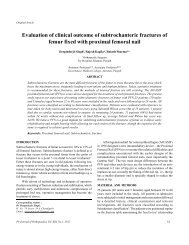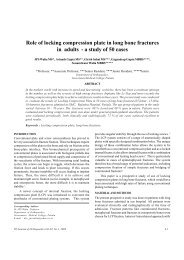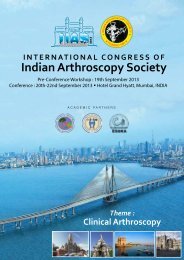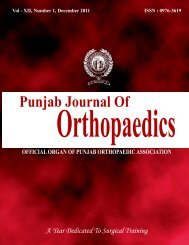Sociodemographic profile of low back pain - Shaharnpur Spine
Sociodemographic profile of low back pain - Shaharnpur Spine
Sociodemographic profile of low back pain - Shaharnpur Spine
Create successful ePaper yourself
Turn your PDF publications into a flip-book with our unique Google optimized e-Paper software.
Original Article<br />
<strong>Sociodemographic</strong> <strong>pr<strong>of</strong>ile</strong> <strong>of</strong> <strong>low</strong> <strong>back</strong> <strong>pain</strong> - <strong>Shaharnpur</strong> <strong>Spine</strong><br />
Amarjit Sidhu*, Gursukhman Sidhu # , Ramesh C Jindal **, Banga Ajay***, Setia Nishat****<br />
* Pr<strong>of</strong>essor,** Assistant Pr<strong>of</strong>essor, *** Senior Resident, **** Diploma Orthopaedics Student<br />
Department <strong>of</strong> Orthopaedics<br />
Maharishi Markandeshwar Institute <strong>of</strong> Medical Sciences and Research Mullana, Ambala<br />
#<br />
Research fel<strong>low</strong><br />
Jefferson Hospital, Philadelphia, USA<br />
ABSTRACT<br />
The general population and the medical community fully recognize that spinal conditions have an enormous<br />
economic impact both on the world’s workforce and on its health care system. 1 Degenerative changes in the<br />
spine is the another cause that may result in loss <strong>of</strong> spinal stability. 2 <strong>Spine</strong> is also vulnerable to conditions<br />
like congenital anomalies, communicable diseases and trauma. This is a prospective non-controlled,<br />
consecutive patient study investigating the Dorsolumbar part <strong>of</strong> the vertebral column <strong>of</strong> 100 adult patients<br />
(68 males, 32 females) suffering from <strong>low</strong> <strong>back</strong> <strong>pain</strong> resulted from various diseases affecting the lumbar spine.<br />
Objective <strong>of</strong> this study was to investigate the prevalence, the consequences and the risk factors associated<br />
with <strong>low</strong> <strong>back</strong> <strong>pain</strong> among general population <strong>of</strong> district Saharanpur that included most <strong>of</strong> patients from<br />
Mohhamadan community. Antero-posterior and lateral radiographs with MRI <strong>of</strong> lumbar spine were done in<br />
all cases. Our series included 26 cases <strong>of</strong> Tuberculosis <strong>of</strong> spine, 23 cases <strong>of</strong> Osteoporosis, 21 cases <strong>of</strong> PIVD, 13<br />
cases <strong>of</strong> lumbar canal stenosis, 8 cases <strong>of</strong> spondylolisthesis, 5 cases <strong>of</strong> spina bifida and 4 cases <strong>of</strong> compression<br />
fracture.The onset <strong>of</strong> LBP in the present study is significant (P
Sidhu et al<br />
part <strong>of</strong> spine that is subjected to heaviest mechanical stress. 7<br />
History <strong>of</strong> onset is significant as it provides clues about the<br />
nature <strong>of</strong> disease and identifies risk factors for developing <strong>low</strong><br />
<strong>back</strong> <strong>pain</strong>. Rural moderate workers are at significantly higher<br />
risk <strong>of</strong> lumbar spine problems, it may be because people in rural<br />
area are subjected to work with poor infrastructure that lead to<br />
trauma to spine resulting in spinal degeneration and <strong>pain</strong>.<br />
Tuberculosis is prevalent in developing countries with lumbar<br />
and thoracic parts <strong>of</strong> the spinal column more frequently<br />
affected. 8 To establish a diagnosis <strong>of</strong> spinal tuberculosis at an<br />
early or late stage when deformities and neurological deficits<br />
are present is the key factor that influences the outcome <strong>of</strong> the<br />
treatment. Osteoporosis and lumbar spinal stenosis are the<br />
most common musculoskeletal conditions in the elderly<br />
population and also are one <strong>of</strong> the most common indications<br />
for lumbar spinal surgery at an advanced age. 9 The direct and<br />
indirect costs <strong>of</strong> Low Back Pain in terms <strong>of</strong> quality <strong>of</strong> life,<br />
productivity and employee absenteeism are enormous making<br />
this common condition the single largest contributor to<br />
musculoskeletal disability worldwide. 10<br />
MATERIAL AND METHODS<br />
A structured questionnaire was administered to all the patients<br />
to sought information on personal characteristics, sociodemographic<br />
variables, job history, smoking status, presence<br />
<strong>of</strong> any <strong>back</strong> <strong>pain</strong> in previous 12 months, severity <strong>of</strong> <strong>low</strong> <strong>back</strong><br />
<strong>pain</strong>, community, treatment <strong>of</strong> their condition and knowledge<br />
about causes and prevention <strong>of</strong> <strong>low</strong> <strong>back</strong> <strong>pain</strong>.<br />
Eligibility criteria: Inclusion criteria were patients with <strong>pain</strong><br />
in the <strong>low</strong> <strong>back</strong> and <strong>low</strong>er extremity with standing, walking or<br />
spinal extension and neurogenic claudication.<br />
1. The <strong>low</strong>er <strong>back</strong> <strong>pain</strong> was disabling to degree that the<br />
patient could not perform his or her routine job without<br />
restrictions and his or her lifestyle had been affected.<br />
2. The exclusion criteria were chosen for safety concerns<br />
as well as to eliminate known confounders that might influence<br />
the results <strong>of</strong> the study or hinder participation and fol<strong>low</strong><br />
through with study protocol. In addition we are excluding<br />
patients with a history <strong>of</strong> lumbar fusion or decompression<br />
surgery as well as interspinous process spacer procedures,<br />
tumors etc.<br />
Design <strong>of</strong> the study: This study is a prospective study on the<br />
clinical course causes <strong>of</strong> <strong>low</strong> <strong>back</strong> <strong>pain</strong> in consecutive cases<br />
presented to Outdoor. It concerns a one year <strong>of</strong> data collection<br />
and the study did not interfere with the usual management <strong>of</strong><br />
<strong>low</strong> <strong>back</strong> <strong>pain</strong> by the general practitioner. The fol<strong>low</strong>ing<br />
information was collected from the records: time between onset<br />
<strong>of</strong> symptoms to first physiotherapy treatment, age, sex,<br />
occupation, economic status, nature <strong>of</strong> <strong>back</strong> <strong>pain</strong> (acute/<br />
subacute/chronic/recurrent), mechanism <strong>of</strong> injury, history <strong>of</strong><br />
smoking, radiology/ pathology, symptom location, time lost<br />
from work due to LBP, history <strong>of</strong> LBP (previous mechanism <strong>of</strong><br />
injury, management etc).<br />
Duration <strong>of</strong> the <strong>low</strong> <strong>back</strong> <strong>pain</strong>: At the initial visit patients<br />
were asked to state the duration <strong>of</strong> the <strong>low</strong> <strong>back</strong> <strong>pain</strong> they were<br />
suffering from. Recent onset and chronic <strong>low</strong> <strong>back</strong> <strong>pain</strong> were<br />
defined according to the standards <strong>of</strong> Quebeck Task Force on<br />
spinal Disorders. 11 Recent onset <strong>low</strong> <strong>back</strong> <strong>pain</strong> was defined as<br />
having duration <strong>of</strong> less than seven weeks at the initial visit.<br />
Chronic <strong>low</strong> <strong>back</strong> <strong>pain</strong> was defined as having duration <strong>of</strong> seven<br />
weeks or more at the initial visit.<br />
Clinical course <strong>of</strong> the <strong>low</strong> <strong>back</strong> <strong>pain</strong>: To ascertain the course<br />
<strong>of</strong> the <strong>low</strong> <strong>back</strong> <strong>pain</strong> and the related disability after the initial<br />
visit, the monthly questionnaires consisted <strong>of</strong>: a question<br />
asking whether the patient had experienced <strong>low</strong> <strong>back</strong> <strong>pain</strong> in<br />
each <strong>of</strong> the five foregoing weeks, a visual analogue scale at the<br />
existing <strong>low</strong> <strong>back</strong> <strong>pain</strong>, and the Roland disability scale. 12<br />
The time to recovery <strong>of</strong> the index episode: The time to<br />
recovery, that is the duration <strong>of</strong> the index episode <strong>of</strong> <strong>low</strong> <strong>back</strong><br />
<strong>pain</strong>, was defined as the number <strong>of</strong> weeks from the initial visit<br />
to the end <strong>of</strong> the episode. A four week <strong>pain</strong> free period was<br />
chosen to define the end <strong>of</strong> an episode, as in most cases the<br />
consecutive weeks with <strong>low</strong> <strong>back</strong> <strong>pain</strong> after the index visit were<br />
fol<strong>low</strong>ed by one or more weeks with <strong>low</strong> <strong>back</strong> <strong>pain</strong>, interspersed<br />
by a number <strong>of</strong> weeks without <strong>low</strong> <strong>back</strong> <strong>pain</strong>. In our opinion, it<br />
would not be right to ignore these periods. Consequently, the<br />
episode was considered to have lasted until the first <strong>pain</strong> free<br />
period <strong>of</strong> four weeks.<br />
RESULTS<br />
Demographic characteristics(Table 1): Out <strong>of</strong> 100 patients<br />
68 were male and 32 were females. Most <strong>of</strong> the patients fell in<br />
elderly age group with 47% between the ages <strong>of</strong> 41-50. As far<br />
as pr<strong>of</strong>ession is concerned most <strong>of</strong> the patients were associated<br />
with wood carving (30%), textile industry (25%) and manual<br />
laborer (22%) fol<strong>low</strong>ed by housewives (15%) and shopkeepers<br />
(8%). Among all the patients (68%) belong to <strong>low</strong><br />
socioeconomic, (28%) belong to middle and only 4% belong to<br />
high socioeconomic status. Most <strong>of</strong> the patients were from<br />
Mohhamadan (75%) community fol<strong>low</strong>ed by Hindu community<br />
(25%) and others (5%).<br />
Perceptions and consequences <strong>of</strong> LBP (Table 2): More than<br />
2/3 (84%) <strong>of</strong> the LBP sufferers developed LBP only after starting<br />
work and (62%) claimed that the LBP was work related. Most<br />
Pb Journal <strong>of</strong> Orthopaedics Vol-XIII, No.1, 2012<br />
75
<strong>Sociodemographic</strong> <strong>pr<strong>of</strong>ile</strong> <strong>of</strong> <strong>low</strong> <strong>back</strong> <strong>pain</strong><br />
Sex<br />
Table 1<br />
Demography characteristics<br />
Males 68<br />
Age<br />
Females 32<br />
20-30 08<br />
31-40 36<br />
41-50 47<br />
51-60 09<br />
Socioeconomic status<br />
Low 68<br />
Middle 28<br />
High 04<br />
Pr<strong>of</strong>ession<br />
Wood carving 30<br />
Textile industry 25<br />
Manual laborer 22<br />
Housewives 15<br />
Shopkeepers 08<br />
Religion<br />
Mohhamadan 75<br />
Hindu 20<br />
Others 05<br />
respondents described their LBP as localized (57%), whereas<br />
(33%) complained <strong>of</strong> LBP associated with numbness or <strong>pain</strong><br />
radiating to the <strong>low</strong>er limb. The consequences <strong>of</strong> LBP on<br />
personal life and work were moderate according to most LBP<br />
sufferers (42%) while severe in (20%). Of LBP sufferers, (65%)<br />
sought treatment for their symptom; <strong>of</strong> those who sought<br />
treatment, 60% received traditional treatments, 27% modern<br />
treatments and 13% both. Most were never diagnosed by a<br />
health care pr<strong>of</strong>essional and only 5% underwent surgical<br />
procedures related to their LBP.<br />
Table 2<br />
Perceptions and Consequences <strong>of</strong> LBP<br />
Develop LBP before or after working<br />
Before working 16<br />
After working 84<br />
Related to work<br />
Yes 62<br />
No 38<br />
Characteristic <strong>of</strong> LBP<br />
Localized LBP 57<br />
LBP with Numbness or <strong>pain</strong> in<br />
Buttock/leg 33<br />
Frequency <strong>of</strong> LBP<br />
Daily 53<br />
Weekly 36<br />
Monthly 11<br />
Recovery <strong>of</strong> LBP<br />
12 weeks 09<br />
Effect <strong>of</strong> LBP on personal life<br />
Little effect 38<br />
Moderate effect 42<br />
Severe effect 20<br />
Effect <strong>of</strong> LBP on work<br />
Little effect 34<br />
Moderate effect 45<br />
Severe effect 21<br />
Modified Job due to LBP<br />
Yes 57<br />
No 43<br />
Treatment <strong>of</strong> LBP<br />
Yes 65<br />
No 35<br />
Types <strong>of</strong> treatment<br />
Modern 27<br />
Traditional 60<br />
Both 13<br />
Receive any <strong>Spine</strong> Surgery<br />
Yes 05<br />
No 95<br />
Pb Journal <strong>of</strong> Orthopaedics Vol-XIII, No.1, 2012<br />
76
Sidhu et al<br />
Heavy Physical work 45<br />
Poor posture 20<br />
Prolonged sitting or standing 24<br />
Falls 06<br />
Do not know 05<br />
Perceived causes <strong>of</strong> <strong>back</strong> <strong>pain</strong> are showed in Table 3.<br />
Pr<strong>of</strong>essional risk factors associated with <strong>low</strong> <strong>back</strong> <strong>pain</strong><br />
(Table 4): The workplace factors associated with LBP were the<br />
seniority in the establishment, pr<strong>of</strong>essional categories, work<br />
posture, necessity <strong>of</strong> lifting objects, self-reported knowledge,<br />
job satisfaction and job stress. Of these pr<strong>of</strong>essional categories,<br />
bad body posture, lifting objects, increased levels <strong>of</strong> lifting,<br />
levels <strong>of</strong> job satisfaction and job stress revealed significant<br />
correlation to LBP (P20 64<br />
Bad body posture<br />
Table 4<br />
Pr<strong>of</strong>essional risk factors<br />
Yes 68<br />
No 32<br />
Knowledge<br />
Not knowledgeable 28<br />
Little Knowledge 54<br />
Knowledgeable 18<br />
Job Satisfaction<br />
Poor 17<br />
Neutral 63<br />
High 20<br />
Stressful<br />
Agree 57<br />
Neutral 35<br />
Disagree 08<br />
Job years<br />
0-5 years 50<br />
6-10years 20<br />
11-15years 12<br />
16-20years 06<br />
>20years 12<br />
The variability in LBP prevalence may be explained by the<br />
methodological heterogeneity used for the assessment <strong>of</strong> LBP<br />
as well as by differences in the gender, pr<strong>of</strong>ession and age<br />
group <strong>of</strong> the other study populations. The onset <strong>of</strong> LBP in the<br />
present study is significant (P
<strong>Sociodemographic</strong> <strong>pr<strong>of</strong>ile</strong> <strong>of</strong> <strong>low</strong> <strong>back</strong> <strong>pain</strong><br />
(30%) and manual laborer (22%). Tobacco consumption was<br />
significantly associated with LBP (P


